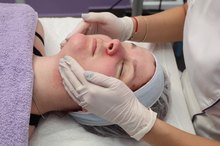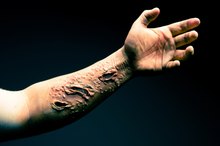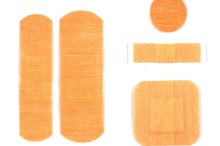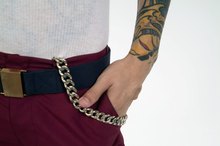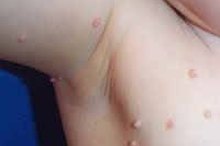What does fact checked mean?
At Healthfully, we strive to deliver objective content that is accurate and up-to-date. Our team periodically reviews articles in order to ensure content quality. The sources cited below consist of evidence from peer-reviewed journals, prominent medical organizations, academic associations, and government data.
The information contained on this site is for informational purposes only, and should not be used as a substitute for the advice of a professional health care provider. Please check with the appropriate physician regarding health questions and concerns. Although we strive to deliver accurate and up-to-date information, no guarantee to that effect is made.
Salabrasion for Removing Tattoos
Tattoos have been a part of human culture for more than 4,000 years, according to Dr. Gary H. Manchester, and the dilemma of removing unwanted tattoos has existed just as long 1. A technique known as salabrasion has been used for centuries to remove tattoos, and although more technologically advanced methods such as laser tattoo removal exist today, salabrasion is still used to remove unwanted tattoos.
While salabrasion is effective for removing tattoos, you need to know about the technique before deciding to erase your tattoo using this method.
Initial Process
Salabrasion tattoo removal uses simple ingredients--plain table salt, tap water and an abrasive device such as a wooden block wrapped in gauze. A local anesthetic is sometimes administered before the procedure, says Patient-info.com, since there may be some pain involved. The salabrasion process takes little more than 30-40 minutes, according to Manchester's report.
First, the person performing the procedure will shave the tattooed area if any hair is present. Then he applies salt mixed with water to the tattooed area, and uses the abrasive gauze surface to vigorously rub the region until it turns a deep, blood red.
He'll then apply an antibiotic ointment and a sterile gauze dressing, which is left in place for three days. After this time, the dressing is removed from the abraded area, and the skin--which will be raw--is covered once again with salt for several hours. Another treatment with antibiotic ointment follows, and it'll be redressed and let heal for three more days.
- Salabrasion tattoo removal uses simple ingredients--plain table salt, tap water and an abrasive device such as a wooden block wrapped in gauze.
- Then he applies salt mixed with water to the tattooed area, and uses the abrasive gauze surface to vigorously rub the region until it turns a deep, blood red.
Later Stages
How to Get Rid of Stitch Scars on the Face
Learn More
Remove the gauze after the second three days. At this point, the skin may appear leathery and have a rough texture.
The salabrasion-affected region of dead skin will begin to separate from healthy skin beneath within one to five more days, pulling tattoo pigment away with it. As the skin heals, remaining pigment naturally leaves the tattoo.
When the skin is fully healed, the tattoo may be completely removed. If remnants of the tattoo still remain, additional salabrasion treatments may be necessary to remove any remaining pigment. Dr. Eric Bernstein, in a report on TattooRemoval.net, states that more than one salabrasion treatment is almost always necessary.
- Remove the gauze after the second three days.
- When the skin is fully healed, the tattoo may be completely removed.
Post-Salabrasion Considerations
While Manchester states that little or no scarring will occur after salabrasion, Bernstein says that salabrasion almost always results in a visible scar.
Salabrasion, while effective for removing tattoos, carries risks. Scarring is at the top of the list--it's possible that you may replace an unwanted tattoo with an unwanted and unsightly scar. Techniques like salabrasion always carry a risk of infection as well, so make sure that if you're planning on using salabrasion to erase a tattoo, you go to a reputable tattoo removal specialist with sterile equipment.
If you're in doubt at all about how you should get a tattoo removed, consulting with your physician is always a good idea. Remember, you have other options besides salabrasion--click the link in the resources section below for more information.
- While Manchester states that little or no scarring will occur after salabrasion, Bernstein says that salabrasion almost always results in a visible scar.
- Techniques like salabrasion always carry a risk of infection as well, so make sure that if you're planning on using salabrasion to erase a tattoo, you go to a reputable tattoo removal specialist with sterile equipment.
Related Articles
References
- NIH - Tattoo Removal, by Dr. Gary Manchester
- Lynn C, Michaela, Herdrich D, et al. The evolutionary adaptation of body art: Tattoo as an honest signal of enhanced immune response in American Samoa. Amer J Hum Biol. 2019:e23347. doi:10.1002/ajhb.23347
- Wilson WT, O’Boyle M, Leach WJ. Unusual complication of a tattoo in an immunosuppressed patient. Case Reports 2018; 2018:bcr-2018-224968. doi:10.1136/bcr-2018-224968
- Oanţă A, Irimie M. Tinea on a tattoo. Acta Dermatovenerol Croat. 2016;24(3):223-4.
- Tohme RA, Holmberg SD. Transmission of hepatitis C virus infection through tattooing and piercing: a critical review. Clin Infect Dis. 2012;54:1167–1178. doi:10.1093/cid/cir991
- Centers for Disease Control and Prevention. HIV transmission. Updated August 6, 2019.
- Warshaw EM, Schlarbaum JP, Taylor JS, et al. Allergic reactions to tattoos: Retrospective analysis of North American Contact Dermatitis Group data, 2001-2016. J Am Acad Dermatol. 2019;2:e61-e62. doi:10.1016/j.jaad.2019.09.077
- Kirby W, Alston DB, Chen AH. The incidence of hypertrophic scarring and keloid formation following laser tattoo removal with a quality-switched Nd:YAG laser. J Clin Aesthet Dermatol. 2016;9(5):43–47.
- Islam PS, Chang C, Selmi C, et al. Medical complications of tattoos: A comprehensive review. Clin Rev Allergy Immunol. 2016;50(2):273-86. doi:10.1007/s12016-016-8532-0
- Valbuena MC, Franco VE, Sánchez L, Jiménez HD. Sarcoidal granulomatous reaction due to tattoos: report of two cases. An Bras Dermatol. 2017;92(5 Suppl 1):138–141. doi:10.1590/abd1806-4841.20175860
- Orzan OA, Popa LG, Vexler ES, Olaru I, Voiculescu VM, Bumbăcea RS. Tattoo-induced psoriasis. J Med Life. 2014;7 Spec No. 2(Spec Iss 2):65–68.
- Ross JR, Matava MJ. Tattoo-induced skin "burn" during magnetic resonance imaging in a professional football player: a case report. Sports Health. 2011;3(5):431–434. doi:10.1177/1941738111411698
- Kaur RR, Kirby W, Maibach H. Cutaneous allergic reactions to tattoo ink. J Cosmet Dermatol. 2009;8:295-300. doi:10.1111/j.1473-2165.2009.00469.x
- Brady BG, Gold H, Leger EA, Leger MC. Self-reported adverse tattoo reactions: a New York City Central Park study. Contact Dermatitis. 2015 Aug;73:91-99. doi:10.1111/cod.12425
- Forbat E, Al-Niaimi F. Patterns of reactions to red pigment tattoo and treatment methods. Dermatol Ther (Heidelb). 2016;6(1):13–23. doi:10.1007/s13555-016-0104-y
- Rosenbaum BE, Milam EC, Seo L, Leger MC. Skin care in the tattoo parlor: A survey of tattoo artists in New York City. Dermatology. 2016;232:484-489. doi:10.1159/000446345
- Khunger N, Molpariya A, Khunger A. Complications of tattoos and tattoo removal: Stop and think before you ink. J Cutan Aesthet Surg. 2015;8:30–36. doi:10.4103/0974-2077.155072
- United States Food and Drug Administration. Tattoos & permanent makeup; fact sheet. Oct 31, 2019.

